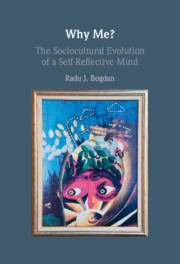Book contents
- Why Me?
- Why Me?
- Copyright page
- Dedication
- Epigraph
- Contents
- Acknowledgments
- Introduction
- 1 Framing the Issue
- Part I The Architecture
- Part II The Evolution
- 4 An Evolutionary Paradigm
- 5 Reasons for Self-Reflection
- 6 Scaffolding Self-Reflection
- 7 A Public Sense of Me
- 8 Questions and Answers
- Glossary
- References
- Index
7 - A Public Sense of Me
from Part II - The Evolution
Published online by Cambridge University Press: 28 May 2021
- Why Me?
- Why Me?
- Copyright page
- Dedication
- Epigraph
- Contents
- Acknowledgments
- Introduction
- 1 Framing the Issue
- Part I The Architecture
- Part II The Evolution
- 4 An Evolutionary Paradigm
- 5 Reasons for Self-Reflection
- 6 Scaffolding Self-Reflection
- 7 A Public Sense of Me
- 8 Questions and Answers
- Glossary
- References
- Index
Summary
Under the pressures of sociocultural self-regulation, the projective and autobiographical sense of a virtual and displaced self develops initially in a public format that emulates and internalizes an outside perspective, that of an external observer, under publicly shared concepts and terms. Section 7.1 elaborates the notion of a public construction of an autobiographical sense of me-self. Section 7.2 examines the perspectival mechanisms, mainly mental imagery and narrativity, that internalize a regulatorily external observer angle on one’s self-strategizing. Finally, according to Section 7.3, self-strategizing would not be adaptive and effective, and the other requirements (examined in this and the previous chapter) would not be met, unless the reflective mind is also able to represent its own states and attitudes in the same public concepts and terms in which it represents the states and attitudes of other minds, which is another facet of an initially internalized public regulation of one’s self-strategic mind.
- Type
- Chapter
- Information
- Why Me?The Sociocultural Evolution of a Self-Reflective Mind, pp. 136 - 171Publisher: Cambridge University PressPrint publication year: 2021

